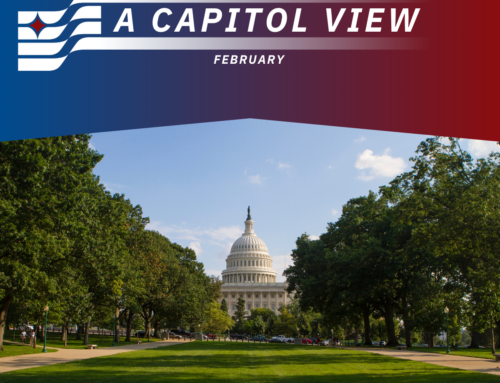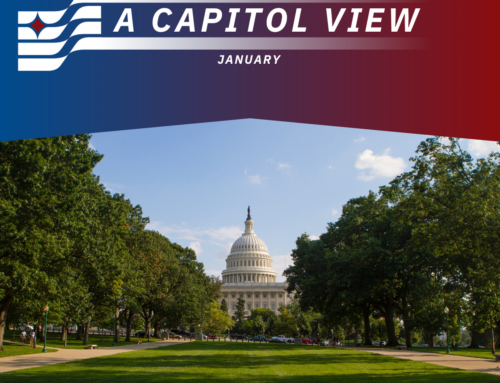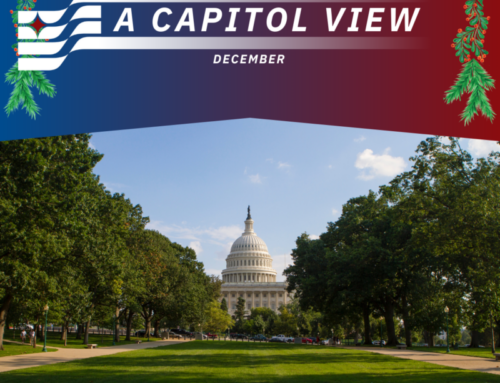Greetings from Washington D.C.:
We hope you and your loved ones are staying healthy during this challenging time. The U.S. Federal Government has been focused on supporting those in need during this severe economic disruption. However, we continue our work as appropriate to advocate for the marine energy industry. Our top priority is increasing funding for the U.S. Department of Energy (DOE) Water Power Technologies Office (WPTO) through any upcoming economic stimulus package or the regular appropriations process. Our goal is to secure the federal investments needed to support a faster transition to clean energy technologies and create high-value employment opportunities once we emerge from the COVID-19 pandemic.
Please check out this great article in the Los Angeles Times that discusses the last recession in 2009 and how support for clean energy technologies helped the economy grow again. With the rapid decline of oil prices and growing lay-offs in the fossil fuel industries, now is the time to help displaced workers shift into the marine energy industry and other renewable sectors.
While most federal employees here in Washington are working from home just like many of us, the DOE staff is still being productive and releasing funding opportunities (see below) to support marine energy technology development. Our team at SMI, which includes three former DOE Energy Efficiency and Renewable Energy (EERE) officials, can help develop proposal strategies and give guidance on how to win awards. Steve Chalk, former Deputy Assistant Secretary for Renewable Energy at DOE, joined SMI last summer and is great at developing strategies for capturing R&D funding for clients. Please contact us if you are interested in learning more.
We will miss seeing our friends at the postponed Water Power Week and 2020 International Conference on Ocean Energy (ICOE) which would have been hosted by the National Hydropower Association (NHA) next month in Washington. Details to come on when those events will be rescheduled. Please stay in touch, be safe, and we look forward to happier and healthier times.
The SMI Water Power Team
Fiscal Year 2021 Appropriations and Potential Economic Stimulus Funding
Over the past several weeks the U.S. Congress has been working on funding to support hospitals, healthcare workers, COVID-19 research, and a variety of economic measures including additional unemployment benefits and small business support programs. These efforts have delayed work on the Fiscal Year (FY) 2021 appropriations bills. While committee markups have been postponed, staff continue to work on the bills in preparation for return to regular order in the coming weeks. We worked with the NHA’s Marine Energy Council (MEC) to support a funding level of $200 million for the DOE WPTO in the FY 2021 cycle. More on that in our next update.
In addition, there are discussions on Capitol Hill about a potential Recovery Act that may fund infrastructure programs based on a preliminary $760 billion plan (The Moving Forward Framework) released by the House Transportation and Infrastructure Committee in January. If there is an economic recovery package, we will work to include provisions in support of the Water Power sector including waiving cost share requirement for universities, small businesses, and non-profits along with securing a big funding injection for “shovel/water ready” projects. We would also seek parity with other renewables should there be a special tax credit package.
New DOE WPTO Funding Opportunity Marine Energy Foundational Research and Infrastructure
DOE announced a $22 million funding opportunity to leverage the expertise and intellectual capital of non-federal research institutions by supporting foundational R&D and expanded testing capacity to advance the marine energy industry. This FOA addresses priorities in the following Topic Areas:
-Topic Area 1: Foundational Research and Development (R&D)
-Topic Area 2: Atlantic Marine Energy Center (AMEC)
-Topic Area 3: Foundational Research Network Facilitator (FRNF)
-Topic Area 4: Current Energy Technology Testing Infrastructure
A recorded informational webinar will be available starting on April 15, 2020 to provide information on the FOA to potential applicants. In addition to describing the FOA in detail, information will be provided on which entities are eligible to apply, what an application needs to include, cost share and other requirements, how to ask questions, and the process for selecting awardees.
Please contact us if you have any questions or need assistance applying for funding.
New DOE ARPA-E Funding
Finally, after almost a decade of lobbying by SMI and the industry, DOE announced up to $38 million in funding for a new Advanced Research Projects Agency-Energy (ARPA-E) program, Submarine Hydrokinetic And Riverine Kilo-megawatt Systems (SHARKS). The program seeks to design economically attractive Hydrokinetic Turbines (HKT) for tidal and riverine currents. For more information on ARPA-E’s SHARKS program, click here. To apply for funding, visit ARPA-E eXCHANGE here.
Please contact us if you have any questions or need assistance applying for funding.
First Round Winners Announced – DOE WPTO and NOAA Prize
DOE, along with the National Oceanic and Atmospheric Administration (NOAA), announced eleven winners of the first round $3 million prize competition to generate innovation in marine energy-powered ocean observing platforms. The Powering the Blue Economy™ Ocean Observing Prize is designed to accelerate technology development through a series of contests to demonstrate marine renewable energy-powered ocean observing platforms. Congratulations to MEC member CalWave, which won the DISCOVER competition!
DOE Seeks LCOE Update from Industry
DOE and the National Renewable Energy Laboratory (NREL) are updating baseline and long-term Levelized Cost of Energy (LCOE) targets for wave and tidal energy converters. A strawman of LCOE targets has been generated for both wave and tidal power for 2020 and 2050, and informed feedback of industry on these targets would be appreciated. To facilitate feedback, DOE and NREL have created a spreadsheet with the strawman values for various factors contributing to LCOE. They would appreciate review of the targets and feedback on any suggested changes to these targets. While providing feedback, please:
-Select either the “Wave” or “Tidal” tab (or both).
-Please consider the industry as a whole in your feedback, not just your enterprise.
-Base your feedback on an assumed 100 MW array/device.
-Explain the thinking behind your feedback in the comment boxes provided.
Responders can record feedback directly on the spreadsheet and return the saved file to David Greene at David.Greene@nrel.gov. Please also contact David with questions related to the process.
System Advisor Model (SAM)
NREL released the new marine energy-enabled version of its System Advisor Model (SAM), a free software tool used to conduct techno-economic evaluation of energy devices. DOE encourages you to download the current release and see how it can help improve your cost and energy estimates. You can find guidance and download instructions here.
U.S. Stimulus Measures Supporting Workers and Business
Paycheck Protection Program
Provides loans for eligible small businesses, certain nonprofits, veterans organizations, or tribal businesses with less than 500 employees. Loans can be used for payroll support, such as employee salaries, paid sick or medical leave, insurance premiums, along with mortgage, rent, and utility payments. Eligible borrowers must make a good faith certification that the loan is necessary due to the uncertainty of current economic conditions caused by COVID-19; they will use the funds to retain workers and maintain payroll, lease, and utility payments; and, are not receiving duplicative funds for the same uses from another SBA program, Paycheck Protection Program FAQs.
Entrepreneurial Development Program
Authorizes SBA to provide additional financial awards to resource partners (Small Business Development Centers and Women’s Business Centers) to provide counseling, training, and education on SBA resources and business resiliency to small business owners affected by COVID-19.
Loan Forgiveness Program
Establishes that the borrower shall be eligible for loan forgiveness equal to the amount spent by the borrower during an eight-week period after the origination date of the loan on payroll costs, interest payment on any mortgage incurred prior to February 15, 2020, payment of rent on any lease in force prior to February 15, 2020, and payment on any utility for which service began before February 15, 2020. Amounts forgiven may not exceed the principal amount of the loan. Eligible payroll costs do not include compensation above $100,000 in wages. Forgiveness on a covered loan is equal to the sum of the following payroll costs incurred during the covered eight week period compared to the previous year or time period, proportionate to maintaining employees and wages: Payroll costs plus any payment of interest on any covered mortgage obligation (which shall not include any prepayment of or payment of principal on a covered mortgage obligation) plus any payment on any covered rent obligation + and any covered utility payment.
Marine Energy Opportunity
Marine energy represents the next generation of renewable power technologies. Marine energy (produced by waves, tides or currents) has tremendous potential to provide significant amounts of clean, renewable electricity while creating high-value employment opportunities. In addition, marine energy is reliable, predictable and environmentally friendly. The resource is close to population centers and can provide power to many different maritime markets and emerging Blue Economy opportunities. Finally, marine energy can help to revitalize our nation’s ports and shipyards as devices can be built and maintained near generation sites.
We continue to be encouraged by the European Commission report on wave and tidal energy which has forecast global installed capacity to hit up to 3.9 GW by 2030 based on current levels of political support. Ocean Energy Europe predicts that by 2050, 100 GW of marine energy can be installed in Europe which would meet ten percent of European electricity demand. The International Energy Agency Ocean Energy Systems 2050 Vision predicts 300 GW of global marine energy installed capacity, with $35 billion in investment and 680,000 direct jobs. Our goal is to see a significant portion of these benefits accrue to the United States along with our friends and allies.
Recent news on marine energy projects from around the world can be found at RENews – Wave and Tidal or the IEA-Ocean Energy Systems Country Reports. You can also find updates on the PNNL Tethys or the DOE Water Power News sites.




